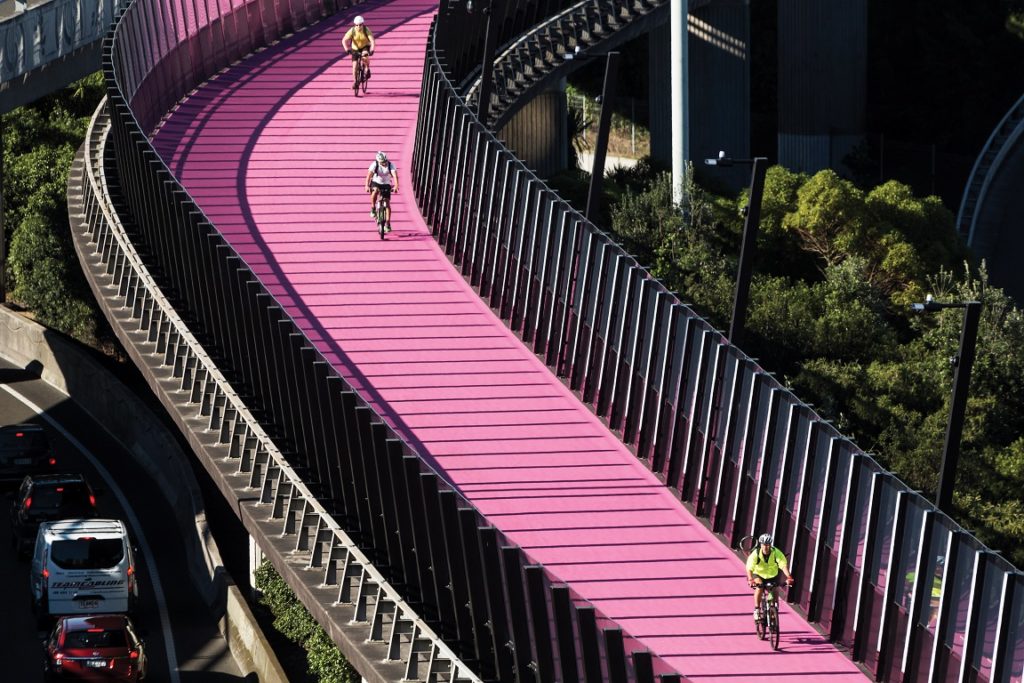
An Auckland off-ramp that stood unused for 10 years has been transformed into a colourful, striking and award-winning urban space.
The Nelson Street Cycleway project with its distinctive magenta-coloured surface is winning recognition both in New Zealand and globally.
Prestigious awards from the likes of the New Zealand Planning Institute, the Institute of Public Works Engineering Australasia, NZ Architecture, NZTA Bike to the Future and the Chicago Athenaeum showcase the significance of this addition to Auckland’s transport network.
The NZ Transport Agency’s Auckland Project Delivery Manager Mieszko Iwaskow says the Nelson Street project is a great example of how it’s possible to reuse infrastructure to improve transport connections.
“Converting the unused Nelson Street off-ramp into a walking path and cycleway was an ambitious project – and one that has proved to be a hit with the public and has already become an iconic piece of Auckland infrastructure,” he enthuses.
The cycleway was the result of a multi-disciplined collaborative effort delivered by the hard work, dedication and commitment of the NZ Transport Agency (NZTA), lead designers GHD, Canada Street Bridge designers Novare Design, architects Monk Mackenzie and contractors Hawkins.
The Central Motorway Junction Walking and Cycling Masterplan (2012) had identified that the project could provide good walking and cycling connections and enhance the area through the Central Motorway Junction by utilising the 7m wide, 670m long off-ramp made redundant as part of the Central Motorway Junction upgrade.
However, it was not until NZTA got the go ahead to provide a link between Grafton Gully Cycleway and Nelson Street that this idea began to take shape. NZTA engaged GHD and Novare Design together with Monk Mackenzie to deliver the design, with GHD also providing construction management.
The project focused on a 1km route that travelled over the disused Old Nelson Street off-ramp, connecting to Canada Street and Upper Queen Street via a bridge over State Highway 1 (Canada St Bridge) before linking into the Grafton Gully Cycleway.
“Timeframes were tight – GHD was challenged with designing and delivering a project that would usually take around two years in just over a year,” recalls GHD Design Manager and Engineer’s Representative Gansen Govender.
The core team of GHD, Novare and Monk Mackenzie was immediately faced with several design challenges:
- delivering a cycleway by summer 2015, including bridging State Highway 1 to provide a new connection – just 14 months
- assessing the scheme and design of a new 1km cycleway requiring major infrastructure design
- utilising a disused existing off-ramp to fit new infrastructure
- obtaining building and resource consents required within this accelerated time frame
- keeping the off-ramp available for use as an emergency detour for cars and light vehicles.
The initial task was updating the scheme assessment report and selecting the optimum route which best met geometric challenges, safety concerns, structural viability, CPTED (Crime Prevention Through Engineering Design) recommendations, consent ability and security concerns.
The Auckland Motorway Authority (AMA) had completed an options report in 2014 identifying a bridge connection to South Street as the preferred option, but GHD provided six more options – four of which were variations of AMA’s preferred choice.
However, it immediately became apparent that the South Street options had key safety and geometry issues, which did not make them viable.
The remaining options generated by the GHD scheme assessment were:
- a shared path on one section of Canada Street leading to an off-road cycleway on NZTA-designated land
- a fully off-road cycleway, also on NZTA-designated land.
The latter significantly reduced consenting and consultation risk but increased the engineering complexity, so the former option was selected. The advantages of this option included reduced cost, liaison and consultation requirements with stakeholders, construction complexity and fundamentally reduced programme duration and risk.
However, the preferred option brought many engineering challenges, in particular the steep topography of the land, while it soon became apparent the embankment was a designated 100-year overland flowpath.
A risk and opportunity review that included feasibility saw the team come up with a workable solution – extend the bridge by doubling its length to traverse the overland flowpath, avoid services and remove consenting programme risk.
This change came within weeks of the tender launch and updates needed to be managed in a staged approach during the tender process, with every effort made not to delay the summer 2015 opening date.
Bridge begins
Attention then turned to the Canada St Bridge that was created by Novare Design and Monk Mackenzie to connect Canada Street to the old off-ramp, spanning one of the busiest sections of the New Zealand road network.
The bridge’s form was guided by its transportation function, namely to span a maximum distance of 54m over State Highway 1 while minimising traffic disruption. The engineering solution was to design a steel structure, whose components could be prefabricated offsite and then safely lifted into place in overnight road closures, minimising disturbance to road users whilst spanning the required distances. In total, the bridge is made of seven spans and is 160m long.
Following the AUSTROADS Cycleway Guidelines adopted on the adjacent Grafton Gully Cycleway, the bridge features a:
- 3.5m width
- 2 per cent camber
- minimum 24m radius
- maximum 4.4 per cent gradient
- 1.4m high barrier
- bridge landing onto an off-ramp with a 10 per cent camber.
Due to the complex geometrical requirements of the space available, the bridge has five horizontal curves, with two different radii.
The value engineering applied to the screens for safety and ease of construction meant that the screens could be placed in front of the existing guard rail as opposed to behind, providing several advantages:
- greater access for maintenance – the perforated panel height could increase as the ratio was no longer governed by the guard rail height
- standardisation – posts and connections could be standardised for maintenance
- safety – with the screens now placed in front of the guard rail, this removed any protruding objects such as the guard rail
- aesthetics – the screen façade was independent of the guard rail
- reduced costs – standard sizes/connection detail and reduced use of Plexiglas.
Screen solutions
Key design challenges to retrofitting new screens to the old off-ramp included:
- avoiding existing reinforcement in the bridge deck
- more than 600 posts on the off-ramp
- a 10 per cent camber on the existing off-ramp gradient
- unevenly spaced guard rail uprights that varied in distance from 1.1 to 2.2m apart
- variable centre point height ranging from 490mm to 575mm
- bolt spacing on the guard rail that varied from 100-120mm and 210-230mm centres
- guard rail widths of either 230mm or 245mm.
The team developed standardised posts and connections that could arrive on site prefabricated and then bolted into place, with no welding or corrosion protection or painting required.
Some of the novel design solutions created to address these constraints were:
- reinforcement – to avoid reinforcement, each base plate had three options in each corner to make one bolted connection
- maintenance – the perforated panels were increased to 1.2m high from 300mm to provide greater access
- accessibility – the Plexiglas and perforated panels were designed to be opened independent of each other, allowing the perforated panels to be removed for maintenance while keeping the Plexiglas in place and providing a safer worksite
- uneven panel widths – a 200mm clamping plate system placed in front of the column provided sufficient tolerance behind the plate to reduce the variation of panel widths, with 14 standard panel widths sufficient for more than 600 unevenly spaced posts
- optimised connection detail – resulting in 18 post variations capable of covering all guard rail connection variances
- standardised product – posts could be prefabricated and corrosion-protected off-site, meaning no welding or corrosion protection on site, thus enabling better quality control
- aesthetics and safety – the screens were carefully designed to provide a uniform even façade between Plexiglas and perforated panel, which required staggered coupling nuts and spacer detail to millimetre accuracy.
Ultimately the project team value engineered a new solution from first principles during construction, with no impact to the programme and achieving both construction and whole-of-life cost savings.
Visual value
Towards the mid-point of construction, Auckland Council set about investigating potential off-ramp enhancements inspired by the unique location of the cycleway.
Project architects Monk Mackenzie were re-tasked with developing concepts, resulting in a series of concept workshops where the project team, in particular GHD and Hawkins, reviewed the constructability and advised on what could be achieved within the construction programme
Several concepts were taken to detailed design and construction:
- Maori artwork – designed by a local Maori artist taking the history of the land and the people into consideration, they consisted of 15 etched steel carvings of humanistic figures along the cycleway, in addition to a 6m-high carved steel post marking the entrance to the off-ramp (Pou)
- magenta surfacing on the off-ramp including a koru design – the magenta surface was chosen due to its reference to the heartwood of the totara tree, a feature that’s not only distinctly New Zealand but also reflects the ‘modern’ public consultation directive
- interactive lighting design – 290 LED columns, each 3m high with motion sensor lights capable of mimicking either pedestrians or cyclists’ movements and enhancing their experience.
This substantial design change mid-construction required complete collaboration from the project team, in particular between the designers and contractor, to handle several complexities:
- the 290 LED columns are a completely unique design, bespoke to this project
- the necessity of redesigning all the street lighting and CCTV on the off-ramp to be located on the eastern side to facilitate city views
- sourcing suppliers for special products such as the magenta surfacing or the outdoor UV protected data and power parallel trunking that provided data protection from power interference
- the addition of 17 new columns which were in advance of the off-ramp and guard rail, requiring new post designs.
These changes outside the scope of the original works resulted in an approximate four-week extension, which brought the works up to the end of spring 2015 – well within time for the summer 2015 opening.
Delivered to the NZTA ready for a December 3rd, 2015 opening with Minister Simon Bridges, the Nelson Street Cycleway evolved a collaborative delivery-focused environment, which required the NZTA, GHD, Novare, Monk Mackenzie and Hawkins to cooperate in several key areas.
These included:
- company culture – each organisation had a culture which fostered a partnering approach, meaning individuals were encouraged to collaborate
- empowering decision-makers – each organisation selected individuals to lead the project who had the right expertise to deliver and empowered them to make decisions, facilitating a streamlined delivery and removing the bureaucracy which would have otherwise derailed the programme
- attitude – the individuals who formed the project team had a positive ‘can do’ attitude combined with a mature approach to contract management, resulting in a collaborative approach as opposed to adversarial.
This project has set a benchmark for cycling projects in New Zealand and is already proving to be a drawcard for tourism and business.
It’s set to gain further global acclaim as a finalist at the World Architecture Festival in Berlin in November.
This article appeared in the August issue of Asia Pacific Infrastructure News.




